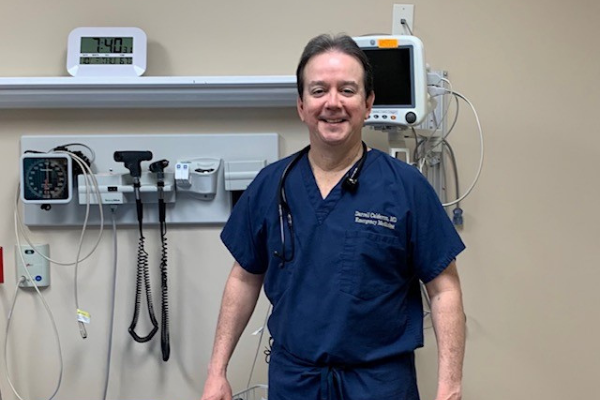
As an emergency physician in the Houston area, Darrell Calderon, MD, has dealt with his fair share of COVID-19 patients. And like other physicians, he had to contend with a steep learning curve when the disease began spreading statewide in March 2020.
“One patient walked in [to the emergency department] and she was diabetic, vomiting, diarrhea, and we thought she had some sort of diabetic complication,” he said.
Then he checked her blood oxygen level, which turned out to be dangerously low.
“I was like, ‘Oh, my goodness. Everyone, stop! Get out of the room! Gown up – this is COVID.’”
Since then, Dr. Calderon and other emergency physicians have become savvier about recognizing how the disease presents and how to treat it. But that knowledge was hard-earned at times.
“We had a lot of decisions we had to make on the fly, and it was like, ‘Is this the right thing for the patient?’” he said. “The information kept changing about COVID management and, being a small hospital out in the periphery [of a big city], we didn’t have access to some of the cutting edge – for the time – therapy and management.”
Like other physicians treating COVID-19, Dr. Calderon learned a lot through experience. He also relied on a network of physicians at larger hospitals in Houston and New York City to discuss cases and best practices.
There were plenty of other stressors as well, such as shortages of personal protective equipment and news that fellow physicians had died or been forced to retire because of COVID-19.
“It hits home when you have friends who you lose to COVID,” he said. He added: “[There was also] not knowing, am I taking this home to my family? I would basically change and shower at the hospital and wash my clothes separately from my family’s clothes.”
Amid all this, Dr. Calderon understood his job was not secure. When the pandemic started, the small 50-bed hospital near Houston where he worked already struggled financially. Fear of catching the disease caused people to avoid all medical institutions for weeks. That drop in patient load caused the hospital to shut down and forced Dr. Calderon to go job hunting.
“It was just a stressful situation,” he said. “I was taking care of COVID patients, but you had to worry about your job and livelihood and everything. It was just difficult all the way around.”
Today, Dr. Calderon works for two free-standing emergency departments near Houston as well as the city of Houston’s Emergency Telehealth and Navigation (ETHAN) program. It allows first responders to use telemedicine to contact emergency physicians so they can triage cases before patients reach the hospital.
Physicians have learned some important lessons about medicine because of the pandemic, like the effectiveness of masking as a preventive measure against all respiratory illnesses, not just COVID-19, Dr. Calderon says.
But the most effective techniques are the ones physicians have always used – including empathy and a willing ear, he says. Since he’s been a patient in an emergency department himself, he tries to put himself in the patient’s shoes.
“The biggest complaint that patients have is that the doctor didn’t listen,” he said. “So take the extra time. Don’t cut them off. Listen to the patient. Sit and discuss things and eventually the patient will tell you what’s wrong with them.”
He’s learned to deal with the added stress caused by COVID-19 by spending time with family, fishing, and having a regular Zoom chat – which may turn into a happy hour – with friends from medical school.
Dr. Calderon is thankful the pandemic finally appears to be easing and wishes it had not been so stressful in so many ways. And yet, he can’t imagine not practicing medicine during this time.
“I signed up for this – I signed up for emergency medicine,” he said. “Would I do it all over again? Heck, yeah. I wouldn’t trade it for anything.”